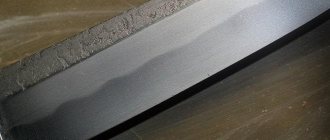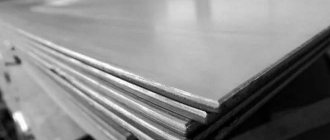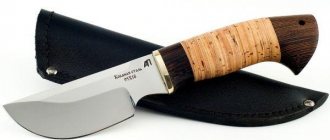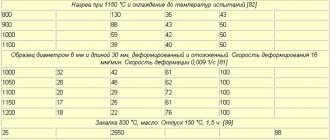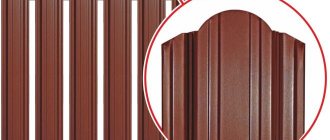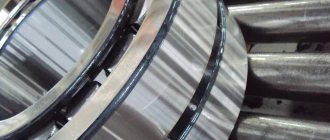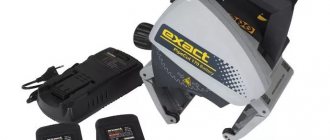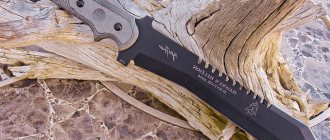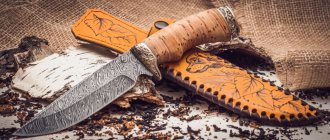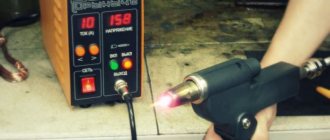Steel 65x13 is tool steel and belongs to the martensitic class. In Russia it is used for the manufacture of cutting tools, which have high requirements for corrosion resistance. Due to its use in medicine (the manufacture of scalpels and other devices designed for long-term use), this steel is also called “medical” or “surgical”. The predominant use of 65×13 steel for knives, the pros and cons of products made from it, are determined by the properties of the alloy.
Knife with steel 65x13 on the blade.
Composition and description of steel grade 65×13
Any steel consists of 2 main elements - iron and carbon. To produce a material with the required characteristics, special additives are used - alloying elements.
Depending on the number of main and additional components, compliance with production technology, a material with the required properties is obtained.
The first numbers in the name of the steel grade indicate the carbon content in hundredths of a percent, then after the letters indicating the additive, they indicate the content of the corresponding alloying element in percent. According to the designation, 65X13 consists of 0.65% carbon and 13% chromium (X), the remaining additives are less than 1%, they are not indicated in the name.
Characteristics of steel 65×13
Steel 65X13 is a high-carbon, high-alloy alloy. The hardness of a metal is directly proportional to the amount of carbon in it. The main alloying component chromium makes steel stainless.
Alloying components
The content of impurities, except chromium, which is indicated in the steel marking, is insignificant in the composition of this alloy, so the knives are easy to sharpen, and the blade can be made of almost any shape.
In the production of 65X13, the following impurities are used:
- Chromium (Cr) – 12.00-14.00% – is part of any stainless steel and is responsible for resistance to corrosion processes, i.e. provides metal resistance to water and increases resistance to mechanical wear.
- Manganese (Mn) – 0.25-0.8% – is used at the steel production stage. It increases hardness, resistance to mechanical stress and shock loads.
- Silicon (Si) – 0.20-0.5% – increases elasticity, corrosion resistance and oxidation resistance at high temperatures.
- Nickel (Ni) – 0.5% – is responsible for the strength of the alloy.
- Phosphorus (P) – 0.030% – is a harmful technological additive. As its amount in the alloy increases, both the strength and fragility of the metal increases.
- Sulfur (S) – 0.025% – is also an additive necessary for steel smelting. Makes the metal brittle and reduces its anti-corrosion properties, ductility, and resistance to mechanical wear.
High-quality stainless steel 65x13.
To obtain the required parameters, the following components can be added to the alloy:
- Molybdenum (Mo) – increases elasticity and anti-corrosion properties.
- Titanium (Ti) – increases the strength characteristics of steel, improves its machinability and corrosion resistance.
- Vanadium (V) – improves the strength properties of the alloy and increases its hardness.
- Tungsten (W) – improves the cutting properties of the blade. This component is used in expensive knife models.
Hardness
Stainless steel 65Х13 due to its composition has increased hardness. The wear resistance of the knife depends on this parameter, i.e. preservation of sharpening.
Knife hardness is measured in HRC units on the Rockwell scale. 65Х13 corresponds to a value from 54 to 59 HRC with proper heat treatment. To determine this indicator, the sample is placed under a press and pressed on it with a diamond cone (at an angle of 120°) or a ball with a force of 150 kgf. Hardness values of 54-58 HRC correspond to good all-purpose knives.
Particularly durable products have an indicator of 59-64 HRC. For example, the hardness of a diamond is 100 HRC. You can find 2 numbers in the designation, in this case the first value is for the center of the blade, the second is for the edge.
High levels of hardness and strength are achieved only in factory conditions.
Sharpening tools
Now let's talk directly about sharpening tools. What they are and what they are eaten with.
There are, roughly, two types of machines and devices for sharpening. The first are manual and mechanical, and the second are electric. Let's say right away that electric machines, in our opinion, do not cope with their responsibilities. Cheap electric sharpeners equipped with diamond rotating discs can only sharpen ceramic knives decently. More serious electric machines are quite expensive and often difficult to use. We will not consider them.
You ask: “Why are they selling them then?” We answer - to earn money while there is a demand for a “magic” device - insert a knife, press a button, “tick” - and you’re done!
Let's talk about manual sharpening devices and about sharpeners with a mechanical (muscular) “drive”.
Traditional way
The traditional method, popular among old-school professionals, is hand sharpening on natural stones or water stones. Water stones (water stones because before use they must be soaked in water until all air bubbles come out of them) differ favorably from natural stones in that they have different grain sizes from coarse (100-120 grit) to very fine (10,000 grit).
Natural stones, for obvious reasons, cannot be presented in such an assortment. They are, as a rule, all small, finishing.
The method of sharpening both on natural stones and on water ones is, in general, similar. Only when working on water stones, we sharpen the cutting edge of the knife not on the surface of the block itself, but on the suspension formed on its surface (an aqueous “solution” of abrasive powder). Therefore, putting too much pressure on water stones is contraindicated. Excessive pressure will cause increased wear on the bar.
Natural stones do not need to be soaked, but they should be moistened from time to time with water or soap suds (so that the surface of the stone does not become clogged with metal dust that will form during operation).
The sharpening angle is set intuitively. Various devices for setting the sharpening angle work only on wide knives with a thin spine (these are, as a rule, kitchen knives such as “Chef”, “Santoku”, etc.).
That is, you need to take a knife or a block and study, study, study, and not everyone likes this. Many, for example, are afraid of damaging (scratching) their knife while learning the sharpening process.
Mechanical devices
For such users, various mechanical devices have been invented to simplify sharpening and reduce its time.
Scraping-pulling scissors
It is better not to use various kinds of scraping and pulling knives with carbide (tungsten carbide, “win”) plates.
Although the sharpening is very fast (a few seconds), it is very asymmetrical and short-lived. It may only be suitable as an emergency sharpening (there is nothing at hand, and a knife or hatchet needs to be sharpened urgently). In addition, such sharpening on carbide elements spoils the cutting edge and greatly reduces the service life of the sharpened tool.
"V-shaped sharpeners"
The so-called “V-shaped sharpeners” are a base made of wood or plastic, on which long bars or cylinders are fixed at a given angle, similar in shape and operating principle to sharpeners, only on a stand and without a handle.
The bars, as a rule, can be set at an angle of 20° and 25°. The first option is suitable for kitchen knives, and the second for tourist and hunting knives. There is no need to intuitively maintain an angle when working with such sharpeners. It is enough to simply pull the blade from top to bottom from the heel of the blade to its tip, holding the knife strictly perpendicular (at a right angle of 90°) to the surface of the table, floor, or ground. Such sharpening does not present any difficulties.
The bars can be diamond-coated or made of hard ceramics. You can press on hard ceramics, but you should not put pressure on diamond (crystals will crumble out of the metal binder). Both can be moistened before use with plain water or soap suds. You can work without lubricant, but then you will have to wash the surface of the bars with a rough sponge and cleaning soap to remove waste metal (a gray coating that clogs the surface of the bar and reduces its working properties).
It is advisable that the set include bars with a medium grit of 400-600 grit (for sharpening) and fine grits of 1000-1500 grit (for finishing).
“V-shape sharpeners” are a good option for a home workshop. We can confidently recommend it to you for use. If we need a different sharpening angle, then we can take the abrasive rods out of the supply and work with them like regular grinding tools. The thing is two in one!
Special sharpening kits
Special sharpening sets with knife holder. The knife is fixed in them and held in a certain position. Here we no longer run a knife along a block, but work with a block fixed to a guide at a given angle. There are quite a lot of such sharpeners; we will roughly divide them into “Lansky-shaped” and “Apex-shaped”.
Lanski-shaped sharpening sets
“Lanski-shaped” sharpening sets - in them the knife is clamped into a special metal (or plastic) holder.
It is convenient to sharpen small knives with a blade length of up to 120 mm in such sharpeners. Long blades have to be sharpened in two or three steps (the length of the guide is not enough), and this is very inconvenient. And, preferably, with a simple rectangular blade section. Blades with a wedge-shaped, diamond-shaped or other complex cross-section are not easy to secure in the holder. We have to “collectively farm” something extra. But the whetstones for such sharpeners come in a wide variety, from diamond to natural. The choice is very large!
Advantages and disadvantages
Knives made of 65×13 steel, if used as intended, retain their properties for a long time - they do not rust, do not break, serve for a long time, and if necessary, can be easily and quickly sharpened at home. Moreover, goods made from this alloy are relatively inexpensive.
The main advantages of products made from 65×13 include:
high metal hardness;
resistance to corrosion processes;
ease of care and sharpening;
low cost.
According to reviews from owners of 65×13 knives, they have only 2 drawbacks:
the blade quickly becomes dull, i.e. it needs to be sharpened more often;
Over time, with intensive use, the blade may become deformed.
Stainless steel knife.
Advantages of knives made of steel 65×13
Let us take a detailed look at the advantages and disadvantages of products made from this type of steel. There are rave reviews and sharply negative statements on the Internet. The undeniable advantages include: the hardness of the steel, ease of sharpening. The working edge does not chip and resists impacts and bends well. The absence of alloying additives that impart increased strength allows the product to be made to absolutely any geometry.
Thus, the advantages of knives made of steel 65×13 are their following qualities:
- Good resistance to oxidation and various adverse external factors.
- Low price range.
- They do not require special care.
- Sharpen quickly and sharply.
- They are easy to process (polishing, cleaning).
Steel knife
Scope of application of steel 65×13
Steel 65×13 is used in food, woodworking, medical and other industries. Products made from it meet high requirements for corrosion resistance and are able to withstand repeated heat treatment, which is necessary, for example, for medical instruments.
They do not deteriorate in washing machines and do not lose their qualities in chlorinated water. Steel is not affected by food acids and water vapor up to 600ºС.
The main application of this brand is the use in the production of blades and knives for household and professional use. Knives are made for housewives, fishermen, hunters, and tourists.
An example of a popular product is knives made of steel 65×13 for hunting and fishing “Rook”, “Shark”, “Lion”. Thanks to the material, their blade will not “crumple” even with frequent use. The shape of the blade contributes to the correct distribution of the load and facilitates the process of using the knife. The handle is ergonomic. The cost is within middle class prices.
Tips for choosing
When choosing a blade, you should study all its parameters. An important characteristic is geometry. The thinner the blade, the sharper it is. The ideal cross-sectional shape is a wedge (isosceles triangle) or a wedge with a lead (the cutting edge is sharpened at a more obtuse angle).
The most important aspect is the handle. Its shape should be ergonomic, fit well in the hand, and not turn (round handles are a problem with this). There should be no sharp edges, corners, or too many recesses. Gift copies with all sorts of decorations usually turn out to be inconvenient in practice. You cannot choose the hilt of a dagger only by appearance. You definitely need to hold it in your hand. And for a fisherman, hunter or tourist, take into account how comfortable it will be to work wearing gloves or mittens. Many people prefer natural materials for the handle - wood, bone, birch bark, leather. Plastic is usually not so beautiful and noble, but is often stronger and more durable.
When choosing a folding knife, the most important thing to pay attention to is the opening mechanism itself, as well as the lock for locking it when opened. You should try folding and unfolding the “folder” several times and evaluate how convenient it is to do it with one hand. The blade should not wobble from side to side. If there is even a slight play, then most likely the purchase will soon become unusable.
The most popular brands are:
- specializes in the production of comfortable hunting, fishing, and tourist blades. The cost of products made from this type of steel starts from 3,000 rubles. Usually the company gives a branded leather sheath as a gift.
- Pavlovsk hunting knives can be purchased starting from 1,500 rubles. Tourist and universal ones are even cheaper. The variety of assortment is wider.
- As for knives produced by Zlatoust, the price range is even wider - from 2,000 to 18,000 rubles. This is due to the wide range of models.
All three manufacturers have a good reputation, their products are of high quality and are in demand.
Steel 65X13 is the choice of many. There is a wide variety of knives made from it. They may not be as durable as models made from other brands, but they are easier to use in everyday life.
The knife should have a comfortable and durable handle
When choosing a folding knife, you need to check the operation of the mechanism
It is recommended to purchase blades only from trusted manufacturers
